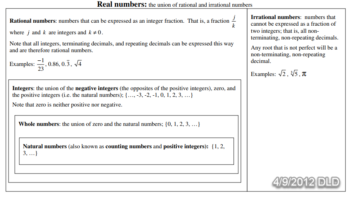New helps added ⇒ Trust the Units and Direct and Inverse Proportional Relationships.
I’ve included some of the content from several math helps that I made for my pre-algebra / algebra classes but displaying math formulas on the web requires a bit more time than I can spare, so you’ll need to view the PDFs to see the full content. Don’t worry, no secret handshake or email address is required — just click the applicable button to view the PDF.
If you use any of my math helps, please attribute “2012 DLD” or “2022 DLD” (whatever is in the footer) — I’d love to hear from you if you do!
The Real Number System
Real numbers: the union of rational and irrational numbers
Rational numbers: numbers that can be expressed as an integer fraction. That is, a fraction j/k where j and k are integers and k ≠ 0. Note that all integers, terminating decimals, and repeating decimals can be expressed this way and are therefore rational numbers. See More on Rational Numbers below for an explanation of how to convert any repeating decimal to its integer form.
Integers: the union of the negative integers (the opposites of the positive integers), zero, and the positive integers (i.e. the natural numbers); {…, -3, -2, -1, 0, 1, 2, 3, …}. Note that zero is neither positive nor negative.
Whole numbers: the union of zero and the natural numbers; {0, 1, 2, 3, …}
Natural numbers (also known as counting numbers and positive integers): {1, 2, 3, …}
Irrational numbers: numbers that cannot be expressed as a fraction of two integers; that is, all non-terminating, non-repeating decimals. Some well-known irrational numbers are π (pi, the ratio of a circle’s circumference to its diameter), φ (phi, the Golden Ratio), and e (Euler’s Number). All non-perfect roots are irrational.
What about numbers that aren’t in the real number system? Why, they are imaginary numbers, of course!
More on Rational Numbers
Rational numbers as decimals and as integer fractions
Given a rational number expressed as an integer fraction reduced to the lowest terms, the quotient of that fraction (i.e. the result of the division) will be one of the following:
- an integer, if the denominator is 1
- a terminating decimal, if the prime factors of the denominator are only powers of 2 and/or 5
- a repeating decimal, if the two previous requirements are not met — note that the repetend (the repeating part) may have up to [denominator minus 1] digits (e.g. if the denominator is 13, the repetend can be up to 12 digits long
Converting repeating decimals fractions to integer fractions
You probably already know how to convert a terminating decimal to an integer fraction, but did you know that every repeating decimal can be systematically converted to an integer fraction, and with a shortcut, it can be done pretty quickly. There is an algebraic method that is best explained with examples, so please refer to the PDF for more details. Based on this method, we can use the following shortcut method:
- To get the numerator, subtract the non-repeating part from the non-repeating part followed by one repetition of the repetend (without decimals).
- For the denominator, append one 9 for each digit in the repetend followed by one 0 for each digit between the decimal point and the first digit of the repetend.
For example, given 0.916, where 91 is the non-repeating part and 6 is the repetend,
- 916 – 91 = 825, so the numerator is 825
- There is 1 digit in the repetend and there are 2 digits in the non-repeating part, so the denominator is 900
The resulting fraction can then be reduced to 11/12.
Another example: given 0.0425871, where 0 is the non-repeating part and 425871 is the repetend,
- 0425871 – 0 = 425871, so the numerator is 425,871
- There are 6 digits in the repetend and there is 1 digit in the non-repeating part, so the denominator is 9,999,990
That’s a big fraction that might take a while to reduce using the usual method of canceling all common factors. But it can be reduced pretty quickly using the Euclidean algorithm described next.
Reducing integer fractions to the lowest terms
Integer fractions can be reduced to the lowest terms by factoring the numerator and denominator and then canceling all factors that are common to both parts. However, the process for converting repeating decimals to integer fractions often results in fractions with large numerators and denominators, which are difficult to factor. For such fractions, it may be easier to use the Euclidean algorithm for finding the Greatest Common Factor (GCF) of two integers (indeed, once you’ve used it a few times, it may well be faster for you for all but the most trivial reductions). To find the GCF using the Euclidean algorithm, first divide the larger number by the smaller number. The remainder will be the new smaller number and the original smaller number will be the new larger number. Repeat this process until the remainder is zero. The last remainder before the zero remainder is the GCF. Note: if the last remainder before 0 is one, then the original integer fraction is already expressed in the lowest terms. There are several examples in the PDF.
Use of Absolute Value When Simplifying Radical Expressions
The textbook explanations that I found for this all seemed to make it more difficult than was necessary to decide if absolute value is needed when simplifying radical expressions. It is really straightforward (in a math-ish sort of way), but hard to describe without some nice math formulas, so please refer to the PDF for details.
Trust the Units When Simplifying Expressions and Solving Equations
It can be very tempting to not include units in our expressions and equations, but they are a great natural “check” on our work.
Direct and Inverse Proportional Relationships
Using direct proportional relationships to find missing information is pretty straightforward, but inverse proportional relationships are often presented in a variety of ways that can be confusing. This method adds one quick step with inverse relationships so that solving them is just as straightforward as solving direct relationships.

